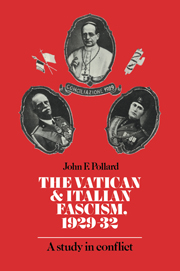Book contents
- Frontmatter
- Contents
- Acknowledgements
- Abbreviations
- 1 INTRODUCTION
- 2 THE ADVENT OF THE CONCILIAZIONE
- 3 REACTIONS TO THE CONCILIAZIONE AND THE RATIFICATION OF THE PACTS
- 4 THE DIPLOMATIC DIMENSION: ITALIAN FOREIGN POLICY AND THE VATICAN, 1929–31
- 5 THE CATHOLIC OFFENSIVE: CATHOLIC ACTION AND THE REGIME, 1929–31
- 6 THE CRISIS OF 1931
- 7 CONCLUSION AND EPILOGUE
- Appendix I The Law of Guarantees of 1871
- Appendix II The Lateran Pacts of 1929
- Appendix III The September Accords, 1931
- Appendix IV A note on archival and other sources
- Bibliography
- Index
7 - CONCLUSION AND EPILOGUE
Published online by Cambridge University Press: 03 February 2010
- Frontmatter
- Contents
- Acknowledgements
- Abbreviations
- 1 INTRODUCTION
- 2 THE ADVENT OF THE CONCILIAZIONE
- 3 REACTIONS TO THE CONCILIAZIONE AND THE RATIFICATION OF THE PACTS
- 4 THE DIPLOMATIC DIMENSION: ITALIAN FOREIGN POLICY AND THE VATICAN, 1929–31
- 5 THE CATHOLIC OFFENSIVE: CATHOLIC ACTION AND THE REGIME, 1929–31
- 6 THE CRISIS OF 1931
- 7 CONCLUSION AND EPILOGUE
- Appendix I The Law of Guarantees of 1871
- Appendix II The Lateran Pacts of 1929
- Appendix III The September Accords, 1931
- Appendix IV A note on archival and other sources
- Bibliography
- Index
Summary
The disputes between the Church and the Fascist Regime in the period 1929–32 were not caused by anything so trivial as differences in interpreting the meaning of the Lateran Pacts, unless, that is, one considers that the conflict over Catholic Action was generated by a difference of opinion over the meaning of Article 43 – and no one, on either side, seems to have suggested this at the time. Any real, practical problems of interpreting and executing the Pacts were resolved by the Joint Implementation Commission, the most obvious example being the thorny question of implementing the clauses of the Concordat relating to matrimony.
The conflicts in this period were about much more serious, substantial and intractable matters, more about each side's interpretation of the overall import and implications of the Conciliazione for the future balance of power between them. Mussolini, for his part, regarded the Lateran Pacts as not only having resolved the ‘Roman Question’ and having reconciled the Church and the Italian State, but by implication he believed that in both a legal and political sense, the Church had been subordinated or even subjected to the State. This much is confirmed by his remarks about the Church being ‘neither free nor sovereign in the Fascist State’.
Having manoeuvred the Church into publicly supporting the ‘Plebiscite’ of 1929, he believed that it was now irrevocably committed to his Regime – as he explained to his brother Arnaldo during the crisis of 1931, ‘We intended that the Church should become a pillar of the Regime.’
- Type
- Chapter
- Information
- The Vatican and Italian Fascism, 1929–32A Study in Conflict, pp. 167 - 194Publisher: Cambridge University PressPrint publication year: 1985

